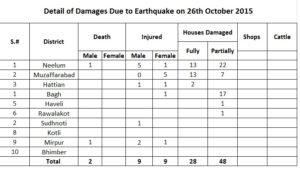Earthquake ,
An earthquake is a sudden, rapid shaking of the ground caused by the shifting of rocks beneath the earth’s surface. Earthquakes strike suddenly, without warning, and can occur at any time of the year – day or night. The impacts of earthquakes include deaths, injuries and property damage, loss of shelter and livelihood, disruption of critical or ‘lifeline’ infrastructure, and destruction of community.
Earthquakes are among the deadliest of natural hazards. Most deaths are due to building collapse or to secondary hazards, such as fires, tsunamis, flooding due to reservoir/dams collapse, landslide and release of chemicals or toxic materials. Earthquake vulnerability factors mainly include: :
-
- non-compliance or non-conformity to building codes
- poor land-use planning
- building in unsafe locations
- unprotected critical infrastructure
- inadequate non-structural measures to secure building contents and equipment
Do’s and Don’ts in Earthquake
Before
-
- Develop an emergency plan for safe and quick exit and practice it regularly.
- Assemble an emergency supply kit: Include food, water, clothing, prescription medications and first aid supplies, a battery operated radio, a flash light, extra batteries, sturdy shoes and personal toiletries.
- Follow the building code and quake proof your house with taking structural measures.
During
Do not panic, remain calm and do not jump from the building. Try and get out of the building from normal / emergency exits. Don’t use the elevator / lift and use staircase. If you are in an elevator during an earthquake, push the button for any floor and get out as soon as you can.
If you are indoors:
-
- If you are unable to move out of building get under heavy furniture such as a table, desk, bed or any other solid furniture.
- Cover your head and chest as you could be hurt by shattered window glass or falling heavy objects.
- Hold on to the object that you are under so that you remain covered. Be prepared to move with the object until the shaking has finished.
- If you can’t get under something strong, or if you are in a hallway, flatten yourself or bend against an interior wall and protect your head and neck with your arms.
- If you are in a shopping mall, go into the nearest store. Stay away from windows, and shelves with heavy objects.
- If you are at school, get under a desk or table and hold on. Face away from windows.
- If you are in a wheelchair, lock the wheels and protect the back of your head and neck.
If you are outdoors
- Stay outside.
- Go to an open area away from all structures, especially buildings, bridges, and overhead power lines.
- If you are in a crowded public place, take cover where you won’t be trampled.
If you are in a vehicle
- Stop the car and stay inside.
- Pull over to a safe place where you are not blocking the road. Keep roads clear for rescue and emergency vehicles.
- Avoid bridges, flyovers, underpasses, buildings or anything that could collapse.
- Listen to your car radio for instructions from emergency officials.
After
- Stay calm. Move cautiously, and check for unstable objects and other hazards above and around you.
- Help those around you and provide first aid.
- Stay out of the damaged buildings.
- Check your home for structural damage and other hazards. If you suspect your home is unsafe, do not re-enter.
- Stay at least 10 meters away from downed power lines to avoid injury.
- Listen to the radio or watch local TV for additional information and safety instructions.
- Inspect gas, water and electric lines for any damages and leaks. If in doubt shut the main switches off.
- Evacuate immediately if you smell or hear gas and you are not able to switch it off.
- Do not light matches or turn on light switches until you are sure there are no gas leaks or flammable liquids spilled.
- Unplug electrical appliances and broken lights to prevent fire due to short circuits.
- Be prepared for aftershocks.
- Put on sturdy shoes and protective clothing to help prevent injury from debris, especially broken glass.
- Check on your neighbours after looking after members of your own household.
- Organize rescue measures if people are trapped or call for emergency assistance if you cannot safely help them.
- If you are near a coastline in a high risk area, immediately move inland or to higher ground and remain there until officials declare the area safe.
- Earthquake 2015


